Visual Art
Treasures from The Harlem Renaissance at Wolfsonian-FIU
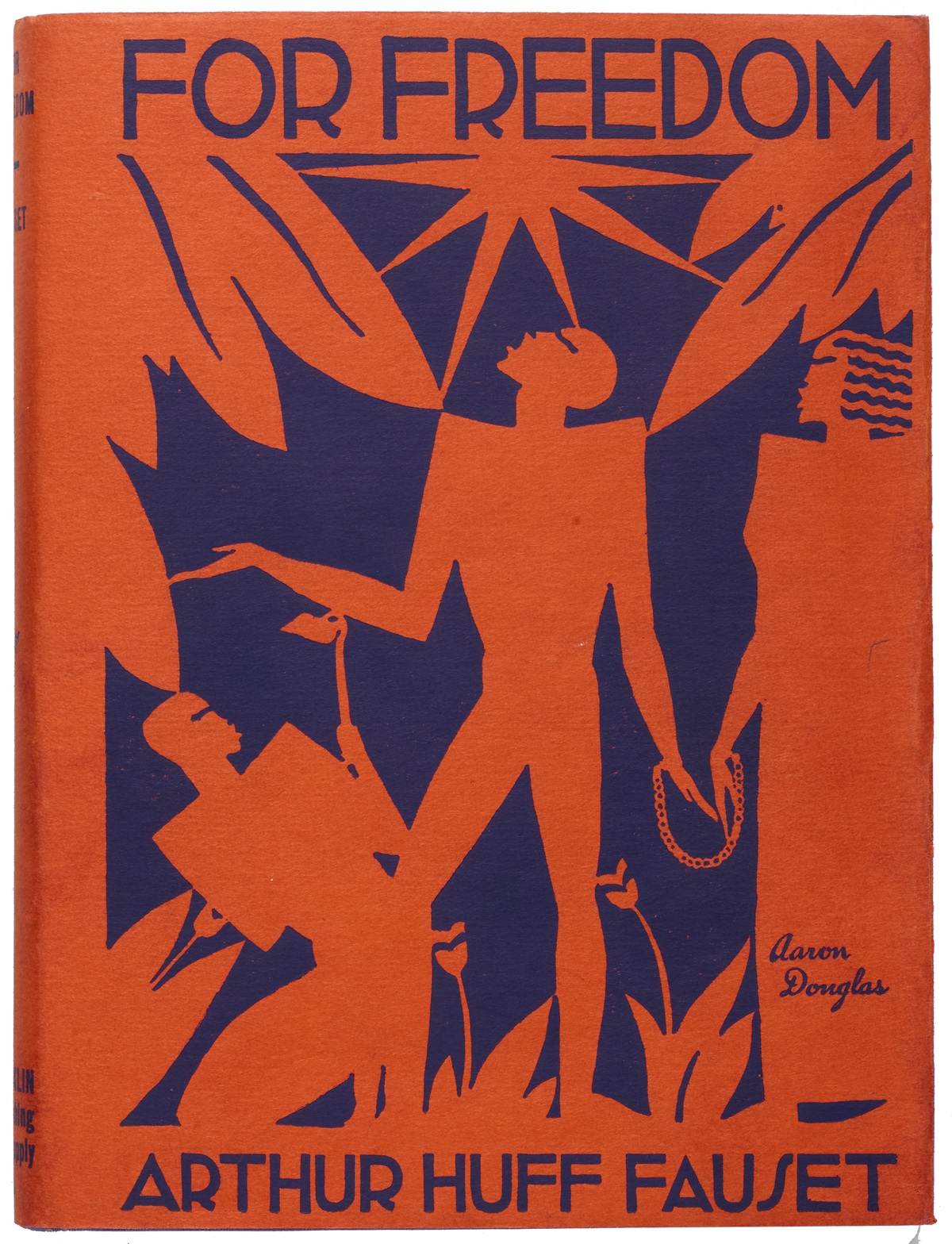
“For Freedom,” illustrated by Aaron Douglas, with interior illustrations by Mabel Betsy Hill, is featured in the exhibition “Silhouettes: Image and Word in the Harlem Renaissance,” on view through Saturday, June 23 at The Wolfsonian-FIU, Miami Beach. (Photo courtesy of the Wolfsonian-FIU)
Most people would say that the Harlem Renaissance only took place in Harlem.
But Christopher Norwood, a Miami-based collector and gallerist, begs to differ.
He says that’s just part of the story.
“Many of the artists that are considered so-called Harlem Renaissance artists never lived in Harlem,” explains Norwood.
And other prominent contributors aren’t originally from there.
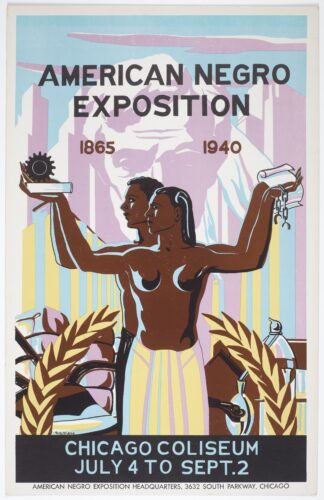
Robert Savon Pious created cartoons, portraits, and illustrations during the Harlem Renaissance including this poster for the American Negro Exposition of 1940 in Chicago. (Photo courtesy of the Wolfsonian-FIU)
Case in point: Leslie Garland Bolling.
“His work was shown in the Virginia Fine Arts Museum, the first Black artist shown in the fine arts museum in the 1930s,” says Norwood. “It was really only HBCU museums that kept a lot of this art alive.”
But in Miami Beach, history buffs and art enthusiasts can see Bolling’s piece at a new exhibit at The Wolfsonian-FIU as part of “Silhouettes: Image and Word in the Harlem Renaissance,” on view through Saturday, June 23.
“It’s a wooden sculpture made with a pocket knife of a bishop of the AME Church, which is arguably one of the oldest Black institutions in this country,” says Norwood.
Included in a section dedicated to Black spirituality and is just one of many items at the event including over 35 book covers and interior illustrations and more than 60 sculptures, paintings, photographs, and prints.
And when it comes to Norwood, the exhibit is just the latest in a fervent discussion that he has been having about the Harlem Renaissance.
This most recent dialogue began almost three years ago after he was encouraged to seek out the Wolfsonian to suss out whether there was an opportunity to collaborate. What he found was a treasure trove of documents and information.
“I met with them. I looked at their archive of artwork, particularly artwork that reflected Black themes, and I was really pleasantly surprised with what they had,” says Norwood.
What he found were photos taken by Carl Van Vechten.
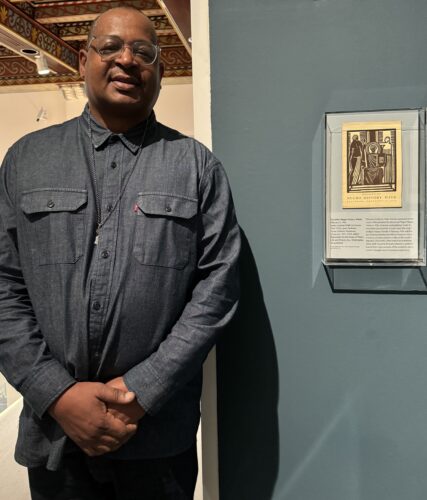
Christopher Norwood curated “Silhouettes: Image and Word in the Harlem Renaissance” at The Wolfsonian-FIU. (Photo courtesy of Yvette N. Harris)
“He’s one of the primary patrons of the Harlem Renaissance,” explains Norwood. “He also was a photographer. He captured a lot of the intellectuals, entertainers and artists, and documented that period in portraits. (The Wolfsonian) had a small collection of original photos as well.”
As Norwood dug deeper, he realized he hit pay dirt. He encountered artwork within first edition books from the Harlem Renaissance that the Wolfsonian had recently acquired.
“The covers. The inside. And for me, I was always fascinated by that artwork because Black artists during this time period were not shown in galleries and museums. So their canvas, for many of these artists, were these books. This way they could actually be seen around the world and around the country.”
Ironically, his findings nearly dovetailed with an event that he was hosting himself.
Norwood is the founder and owner of Overtown based Hampton Art Lovers, a gallery specializing in African American Fine Arts.
At the time he was in the midst of presenting “One Way Ticket: Movement, Migration and Liberty.”
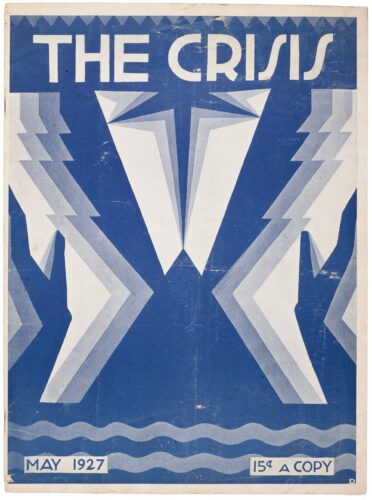
The cover for the Crisis magazine is an iconic example of the artwork produced by Aaron Douglas. (Photo courtesy of the Wolfsonian-FIU )
The show centered on a book of poetry by Langston Hughes’ which was published in 1949 and illustrated by Jacob Lawrence. It documented the experiences of African-Americans who sought an escape from oppression by relocating to the North during the Great Migration.
It was this exchange between Langston and Lawrence, coupled with Norwood’s new Wolfsonian findings which sparked a realization that something must be done.
“I was already in this sort of space where I was really impressed by these collaborations,” says Norwood.
“So when they said they had these collection of books, I was like, Oh, we’re going to do a show focused on these illustrations.’ And what I’ll do is I’ll curate artwork from these artists, but we’ve got to get them from various places.”
One of his first steps was to engage historically Black colleges.
“Fortunately, we have one here in Miami. We were able to have work loaned to us from Florida Memorial. We also had work loaned to us from Fisk University in Nashville, which is home of Aaron Douglas who was the principal artist of that time period, the father of Harlem Renaissance art. He taught there for many years. We also had the Aaron Douglas family loan us work directly.”
With added pieces from his private collection, he then sought (and eventually) received other contributors from various sources including Beth Rudin DeWoody, the Kenkeleba Gallery, and the Norton Museum of Art.
Shawn Christian, an English professor at Florida International University, and a staff member at the Wolfsonian, was brought on board to ensure appropriate attribution and placement.
“We recruited Shawn to be the curatorial consultant so that I could really make sure that I’m positioning the importance of these books in their proper context.”
For his part, Christian was delighted to be a part of the project.
“Being able to personally go back to the time period that I’ve been studying for most of my professional life, and re-enter it through the arts was really powerful because I’m a literary studies scholar,” says Christian. “They were people coming with a different perspective about African American contributions and their role as citizens. And so to tap into that kind of Zeitgeist,in that moment, was really cool.
And like Norwood, he too recognizes the beauty of those who used art to celebrate the set of ideals explored in the New Negro movement.
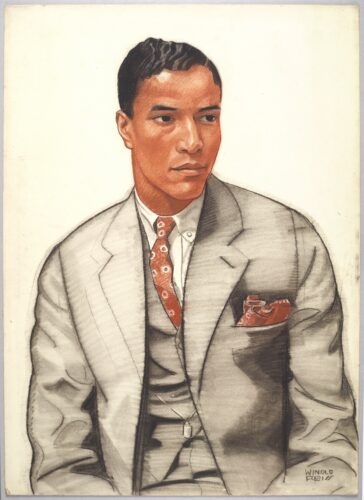
A College Lad” by German born Winold Reiss is just one example of the multiracial collaboration between artists during the Harlem Renaissance. (Photo courtesy of the Wolfsonian-FIU )
“It’s the idea that art can be transformative and socially powerful at this really interesting moment in African American history,” says Christian.
He mentions figures like Alain Locke, Aaron Douglas, Jessie Fauset, Zora Neale Hurston, and James Weldon Johnson, who, he says were encouraged and emboldened to create art, and understood the need to preserve what they were doing during such a transformative period.
“And for a lot of these artists, in addition to wanting to make a living and wanting to make great art they were hopeful that in by doing so, the racial animus of the country would dissipate, or just be removed altogether. It was a lofty, ambitious and arguably crazy goal that in some ways wasn’t realized, but (still) they created this body of work that persists and tells its own story, even to this day,” says Christian.
WHAT: “Silhouettes: Image and Word in the Harlem Renaissance”
WHEN: 10 a.m. to 6 p.m. Wednesday–Sunday. Until 9 p.m. Friday through Sunday, June 23
WHERE: The Wolfsonian–FIU, 1001 Washington Ave., Miami Beach
COST: Free for members, Florida residents, visitors with disabilities and their accompanying caregiver and children under six. Otherwise, $12 for adults, $8 for seniors, students and children 6-18.
INFORMATION: 305-531-1001 or wolfsonian.org
ArtburstMiami.com is a nonprofit media source for the arts featuring fresh and original stories by writers dedicated to theater, dance, visual arts, film, music, and more. Don’t miss a story at www.artburstmiami.com.
